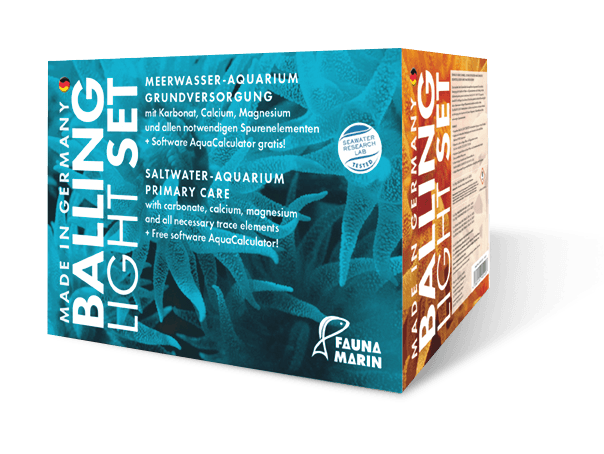Calcium
Calcium is one of the most important elements in sea water aquariums for corals and all other animals. Calcium plays an important role in the structure of skeletal elements of many marine organisms, algae and bacterial biofilms. Here the total consumption does not take place in a consumption relation to the carbonate system, since biofilms and cell functions partly function without the absorption of carbonates in a fixed relation.
What is this:
Calcium is part of the lime supply system and the basis of coral growth. Coral combines calcium with carbonates to form solid lime, calcium carbonate. This occurs in various forms and forms the coral skeleton or the shells of clams.
Problems:
Too low calcium values inhibit coral growth and decrease stability of elements in the salinity line. Too high values lead to precipitation, unstable carbonate hardness values and tissue detachment in corals.
Measures:
Control your calcium value regularly and keep of the calcium according to the salinity line. Switch to the Balling Light supply system for individual adjustment of the calcium.
Indicator species:
Plate-like growing Montipora, Stylophora pistillata var. “Milka”, Echinopora lamellosa Calcium deficiency causes loss of colour and growth disturbances, recognisable by missing growth peaks. With decreasing calcium concentrations, the carbonate hardness value increases significantly. All corals loosing colors, polyp extension, growing tips if the calcium levels is under 350 mg/l (0,26 US.liq.gal.).
Value too high:
Reduce supplemental dosage, check salt mix.
Value too low:
Increase calcium addition via supply system.
| Type | Alkali metal |
|---|---|
| Benefits | Metabolism, coral growth, coral skeleton |
| Standard value | 400–440 mg/l (0,26 US.liq.gal.) |
| Skill Level | green, basic value |
| Source | Salt mix, supply systems, trace element concentrates |
| Available | Elementals Ca, Balling-Light-System, bottom gravel |
| Importance 1–6 | 6 |
| Detection quality | reliable |
| Relation values | strontium, magnesium, carbonate hardness, potassium |
| Fluctuation range | up to 20 mg/l (0,26 US.liq.gal.) |

Balling Light:
Calcium is balanced via canister 1. Depending on the water value, a deficiency or too high a concentration can be compensated by changing the dosage. Direct dosages via Elementals Ca/Sr or Calcium Mix direct are possible. To calculate the amount of the right dosing you can follow this example: Calciumlevel 10 % to less = Dosing + 10 % of the actual dosing amount.
Aragonite solution equilibrium
The growth of corals depends not only on the internal processes in the coral tissue, but also on the composition of the surrounding sea water. The CO2 concentration of saltwater and the resulting pH value as well as the aragonite solution equilibrium are particularly important. The growth of corals takes place in the tissue between the polyps and the skeleton through specialized cells which form a matrix on which calcium in the form of aragonite crystals develops.
A supersaturated calcium solution is attached to these cells to facilitate calcium precipitation. Enzymatic activities ensure sufficient transport of calcium ions into the tissue and hydrogen ions out of the tissue. The dissolved carbon, which is also required for this purpose, is found in the surrounding water in the form of CO2 from bicarbonate and carbonate ions and thus forms the buffer system. The buffer system is stressed by a higher CO2 input, e. g. from calcium reactors or disproportionately high bacterial activity. This decreases the pH value.
More CO2 causes a lower pH value and a decreasing concentration of carbonate ions, as the equilibrium shifts in favour of carbonic acid, i.e. bicarbonate and H+ ions, which leads to a decreasing saturation value for aragonite. At an aragonite saturation of 100 percent, aragonite is in equilibrium between dissolved and solid state. Unfortunately the correct ratio cannot be measured directly. It is therefore important to consider the laboratory results not only as individual values, but as a whole, and to take a holistic approach to the steps necessary for optimizing.
The calcium concentration should be kept stable around 410-440 mg/l (0,26 US.liq.gal.) (at 35 ppt salinity). With our Aquahome water test Ca this value can easily be checked regularly and the supplementation can be adjusted. Too high values should be avoided, as this increases precipitation of calcium and carbonates. Too low values interfere with growth and inhibit nutrient degradation. Please note that individual additions of calcium always have an influence on the carbonate hardness value. The more stable the values are to each other, the better your corals will grow, and the less you will need additional measures to reduce nutrients.
Calcium, magnesium, potassium and carbonate hardness influence each other in seawater. Depending on the salt concentration, the absolute values change, but the ratio remains the same. Always make sure to adjust this ratio as precisely as possible. When individual substances are added, this always has an influence on the other values. Magnesium is the stabilizer that keeps the other values in solution.
Tip:
The calcium supply is an important element of successful reef tank maintenance. We recommend the Balling Light System and its calcium concentration values. These have proven to be efficient and perfect for sensitive corals. Due to the individually adjustable supplementations, the supply system can be customized to any type of aquarium.